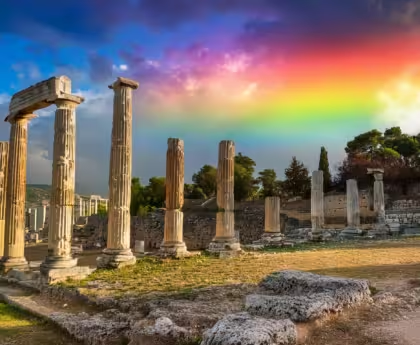The Evolution of LGBTQ Middle Ages to Renaissance
The journey of LGBTQ+ individuals throughout history is marked by significant changes in societal attitudes and cultural norms. This blog post explores the evolution of these attitudes from the Middle Ages to the Renaissance, highlighting key shifts and notable LGBTQ+ figures.
Medieval Europe: Shifts in Attitudes During the Middle Ages
In Medieval Europe, attitudes towards LGBTQ+ individuals were largely shaped by religious and societal norms. The influence of the Church was profound, and homosexuality was often condemned and punished severely.

Early Medieval Period
During the early medieval period, there was a relative lack of structured laws specifically targeting LGBTQ+ behaviours. However, as Christianity spread and the Church gained power, its doctrines increasingly influenced societal attitudes. Homosexual acts were deemed sinful, and religious texts were used to justify persecution.
Legal and Social Persecution
By the 12th century, laws began to codify punishments for homosexual acts. The introduction of canon law by the Church led to harsher penalties, including execution and public shaming. Notably, the Fourth Lateran Council of 1215 mandated severe penalties for heresy, which included homosexual behaviour.
Social Consequences
The social climate of the Middle Ages was one of intolerance and fear. LGBTQ+ individuals often had to conceal their identities to avoid persecution. This era was marked by a lack of public acceptance and widespread stigma.


Renaissance: Changes During the Renaissance Period
The Renaissance, spanning the 14th to the 17th centuries, was a time of cultural rebirth and intellectual exploration. This period witnessed a gradual shift in attitudes towards LGBTQ+ individuals, influenced by the humanist movement and greater emphasis on individualism.
Humanism and Intellectual Exploration
The Renaissance humanist movement encouraged a return to classical antiquity’s values, where same-sex relationships were sometimes viewed with more tolerance. Intellectuals and artists began to explore themes of sexuality more openly, challenging medieval dogmas.
Notable LGBTQ+ Figures
Several prominent figures of the Renaissance were known for their same-sex relationships or non-conforming identities. These individuals made significant contributions to art, literature, and science, often celebrated for their talents regardless of their sexual orientation.
- Leonardo da Vinci: The renowned artist and polymath is believed to have had relationships with men. His notebooks and artworks often contain homoerotic themes, reflecting a more nuanced understanding of sexuality.
- Michelangelo: The famous sculptor and painter had close relationships with men, which are documented in his letters and poetry. His works often depict the male form with an admiration that transcends mere artistic expression.
- Christopher Marlowe: The English playwright was known for his homoerotic themes and is believed to have had relationships with men. His works, including “Edward II,” highlight the complexities of same-sex love in a repressive society.
Shifts in Art and Literature -LGBTQ Middle Ages to Renaissance
Renaissance art and literature began to reflect a more diverse range of human experiences, including LGBTQ+ themes. Artists and writers portrayed same-sex relationships with a depth and sensitivity that challenged previous stereotypes and prejudices.
Legal and Social Changes
While the Renaissance did not completely eliminate persecution, there were areas of greater tolerance. Cities like Florence and Venice were known for their relatively lenient attitudes towards same-sex relationships. However, laws still existed, and LGBTQ+ individuals had to navigate a complex social landscape.

Conclusion: LGBTQ Middle Ages to Renaissance
The transition from the Middle Ages to the Renaissance marked significant changes in attitudes towards LGBTQ+ individuals. While the Middle Ages were characterised by severe persecution and intolerance, the Renaissance brought a gradual shift towards more nuanced and, in some cases, accepting views. Understanding this historical evolution is crucial for appreciating the progress made and recognising the enduring challenges faced by the LGBTQ+ community.
Exploring the lives of prominent LGBTQ+ figures from the Renaissance underscores the importance of individual contributions to cultural and intellectual history. Their stories remind us of the resilience and creativity that have always been part of the LGBTQ+ experience.
LGBTQ Middle Ages to Renaissance
Hashtags
#LGBTQHistory #MiddleAgesToRenaissance #LGBTQMedievalEurope #LGBTQRenaissance #LGBTQFigures #LGBTQArt #LGBTQCulture #LGBTQCommunity #LGBTQPersecution #LGBTQAcceptance #LGBTQHumanism #LGBTQIntellectuals #LGBTQArtists #LGBTQWriters #LGBTQLegalHistory #LGBTQSocialChange #LGBTQResilience #LGBTQProgress #LGBTQInclusion #LGBTQVisibility #LGBTQIdentity #LGBTQSupport #LGBTQEducation #LGBTQEmpowerment #LGBTQPride






